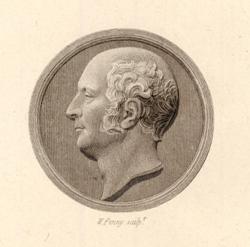
LOVE AND MADNESS
During his enforced stay in Paris, Ferguson became a member of the Institute of France1, becoming ‘acquainted with the most celebrated men of science in Paris'
2. His relationship with these men, and the strings pulled from Britain by Joseph Banks (1743-1820) eventually led to his release. He arrived back at Raith in October 1804; however, it seems he subsequently returned to France to escort Mary Elgin home when she in turn was released from Paris in February 1805, for it was reports of Ferguson's presence on the boat to England that first alerted Elgin to their affair
3. He had them watched and intercepted many of their letters that were described at the ensuing trial as 'the most ridiculous medley of love and madness' that would 'disgrace the worst novel of the last century'
4.
Elgin was released in July 1806 and confronted Mary, who confessed to the affair. Divorce at that time was almost unheard of; furthermore, it would be necessary to take the case through both the English and Scottish courts, at huge expense and scandal for the loser. Nevertheless, believing he would get his hands on his wife's money if he divorced her (he needed it in order to bring the “Elgin Marbles” marbles from the Parthenon to England), in December 1807 (just a month after the Geological Society was founded) Elgin sued Ferguson for the breakdown of his marriage, claiming £20,000 in compensation. The Act of Parliament that divorced Elgin and Mary was passed in 1808 and following the case in Scotland, Elgin was awarded damages of £10,000. However, Mary’s powerful family connections ensured that she protected her vast fortune, although Elgin retained sole custody of their four surviving children, forbidding them any contact with their mother.
In March 1805 Ferguson had been made a fellow of the Royal Society and in 1806, MP for Fifeshire. Living in London, he became a patron of science and was one of the 16 subscribers to Count de Bournon’s (1751-1825) treatise on aragonite5. Meetings about this publication eventually led to the founding of the Geological Society. De Bournon, one of the Society's 13 founders, had been a refugee from the French Revolution when he came to England in 1792. He was immediately elected to the Royal Society because of his expertise in mineralogy. Mineral collecting was very much in vogue among the wealthy elite and de Bournon was employed by some of these men to look after and enhance their collections. Unfortunately, his main patron, Sir Charles Greville (1749-1809), died unexpectedly in 1809, leaving de Bournon with a much-reduced income. Ferguson was one of the four people asked by Parliament to place a value on Greville's collection, which was then purchased by the British Museum for £13,727.